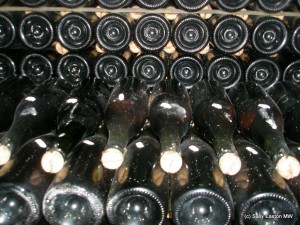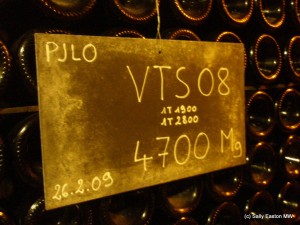Bollinger reserve wines

Bolly reserve wines under cork, in magnum
I love being reminded (oh, so frequently) how little I know about winey stuff. A visit to Bolly, images of the Absolutely Fabulous Jennifer Saunders and Joanna Lumley tumbling through my mind, brought me back from the adorable frivolity of drinking bubbles to the serious side of production and attention to detail.
Making Champagne is undeniably a complex process and one of the added quirks is the use of reserve wines in non-vintage blends. Vintage Champagne, made in the best years, is always the product of a single year. However, in non-vintage bubblies, reserve wines are used to help maintain the consistency of the house style. This is necessary because Champagne is in a cool marginal climate where the grapes don’t always ripen evenly every year. By using some wine from, potentially, several previous years that has been ageing in cool cellars, the negative flavour effects of such climatic vagaries can be minimised.
Bolly go the extra mile with their reserve wines. Not content to store some retained wines from previous years in stainless steel, for example, they store all their reserve wines in magnum, under cork, by village and, of course, by year. All these reserve wines are from premiers crus and grands crus sites.

Organised by village and year, with quantity.
Some 650,000 magnums of reserve wines are stored in their five kilometres of cellar tunnels. That’s the equivalent of nearly half of the total amount of wine they make each year – a pretty big inventory to be sitting on.
Inert glass is one element of the preservation of the wines while they wait to be chosen by the chef de cave to go into the NV blend, before the latter is laid down to complete its second fermentation. In addition to this, the magnums have a small amount of pressure in the bottle. They have a quarter of the tirage (yeast and sugar mixture) that is put into the bottles for the second fermentation. This creates a tiny bit of bubble with 1 to 1.5 bar pressure (up to 6 bar pressure in a finished bubbly), and a bit of yeast lees to help preserve the reserve wines.
All the reserve wine magnums are under cork, because Bollinger have found they have an oxidation risk on bottles/magnums kept under crown cap for more than four years. Bolly keep their reserve wines in magnum for up to 15 years.
Typically 5 to 10% of the non-vintage blend will comprise a selection of these reserve wines. The remainder is usually an equal blend of two previous vintages.
Tasting, in situ, July 2013
Bollinger, special cuvee, NV, Champagne
Tasting a 2010 bottling, which allows for three years of ageing on lees. The blend is about half 2008 and 2009 harvest with a small proportion of reserve wines. In terms of cultivars, special cuvee is typically 60% pinot noir, 25% chardonnay and 15% pinot meunier.
Notes of bread, brioche, dry toast and roasted almonds on the nose. A fine mousse, with sweet bread flavours on the attack and a strawberry perfume, creamy mousse and baked lemons at the back. Really fresh with hints of honey and honeysuckle in a wine that finishes long.



